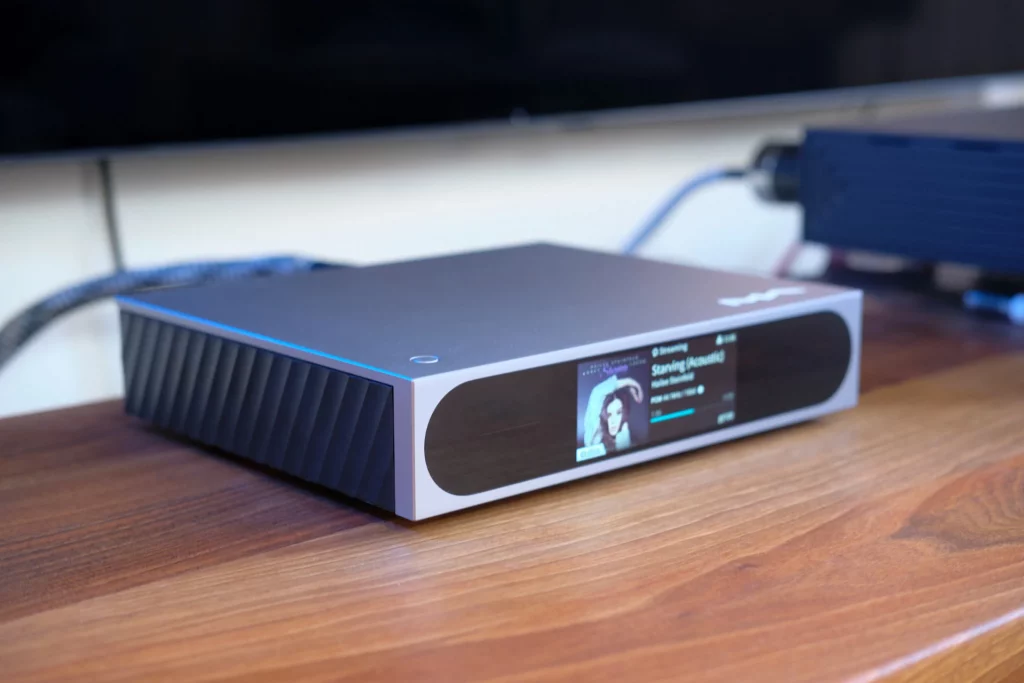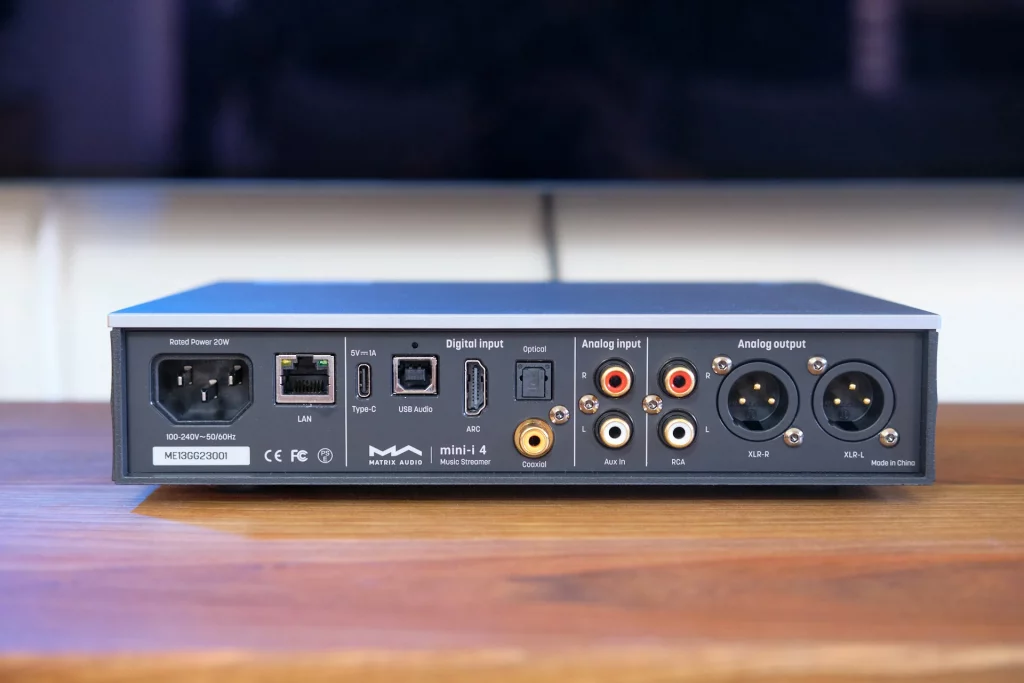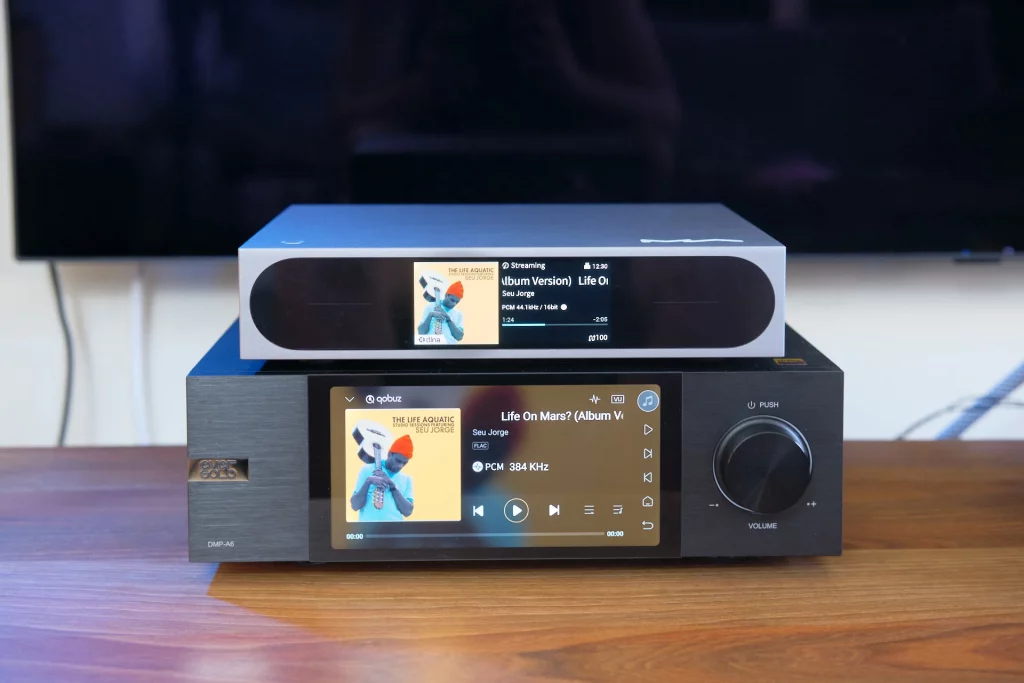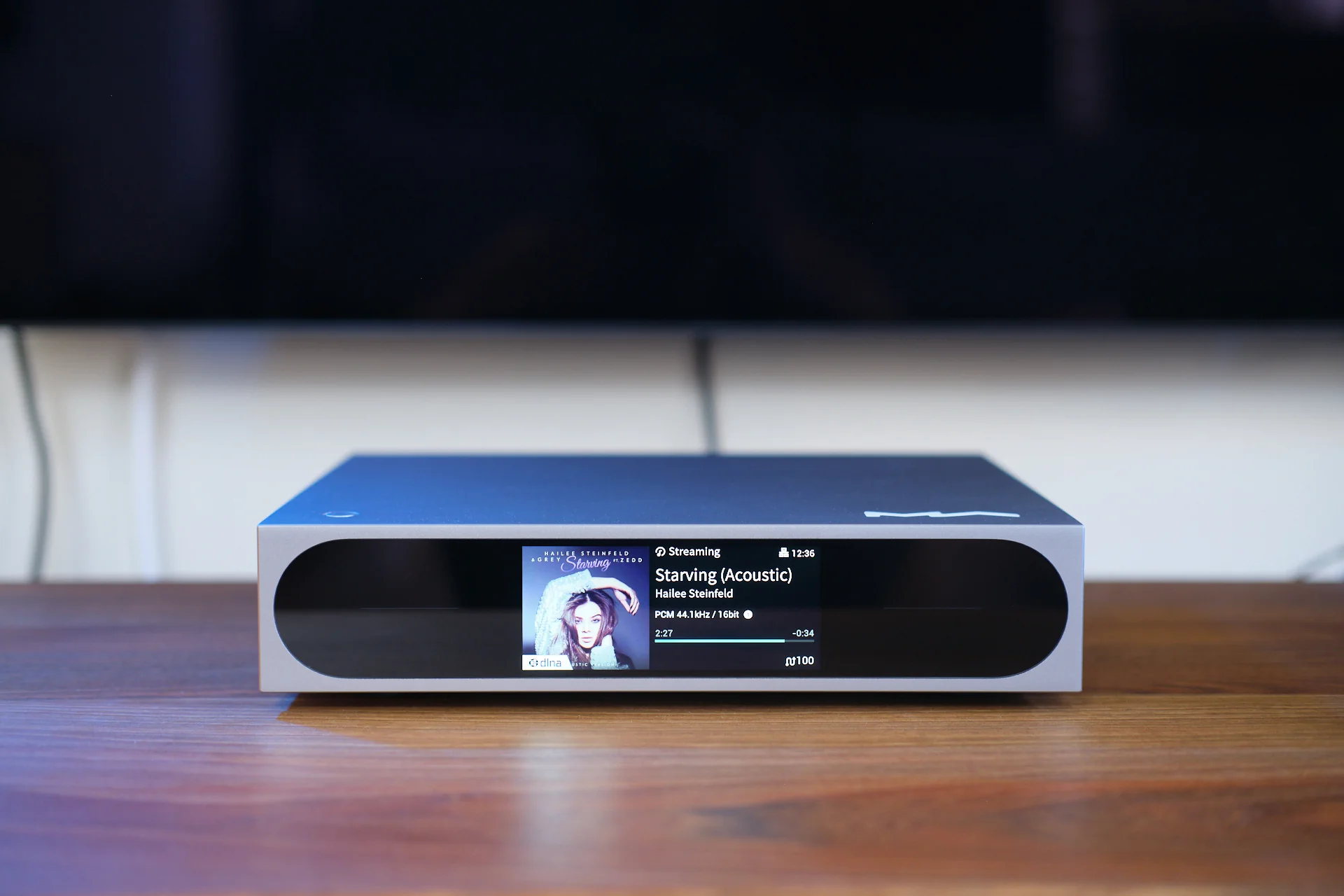Matrix Audio Mini-i 3 gained quite a reputation for being a great-sounding device that doesn’t cost an arm and a leg. Mini-i 4 is a direct successor and refreshment of that model, so let’s see what it is all about.
Build and Connectivity
Overall esthetics of Matrix Audio Mini-i 4 are right up my alley. The unit’s design is dominated by clean and sharp lines, with some snazzy ribbed sides that only look like heatsinks because they are made out of plastic. The rest of the unit is aluminum, however, and built to a very high standard. The color LCD in front is not the biggest you can see on network players nowadays but it’s of good quality. When turned off it blends perfectly with the acrylic black panel surrounding it. There are no headphone outputs on this unit since that is a feature reserved for the Pro model and the only difference between the two.


Moving to the back of the unit, we can see that the Mini-i 4 is powered by AC and the whole power supply is inside the unit. Probably the most important input here is LAN which lets you connect the DAC directly to your home network and enable music streaming functionality. But if needed, more common digital inputs are onboard too: USB, Optical, Coaxial, and HDMI ARC. There’s a set of RCA analog inputs too which we don’t see often in modern devices of this type. On the output side, we can find both single-ended RCA and balanced XLR connectors, which makes this unit very versatile.

Features and Software
As we noticed previously, the touchscreen is not particularly spacious so even though you can use it to command the unit, all of the functions are much more comfortable to use over the MA remote application. But just before we continue talking about the app, it is worth mentioning that remote control is optional and can be purchased at extra cost.
Back to MA remote, it is a well-written software that is feature-rich, doesn’t exhibit any hiccups as far as my experience goes, and is finished with a clean interface that operates smoothly. Matrix did its job well creating a nice-looking and well-behaved streaming platform. Using it, you can operate and control the mini-i 4 through smartphones or tablets within the local network. The MA Remote App is self-developed by Matrix Audio and is available for iPhone, iPad, or Android phones. You can browse and play online audio from TIDAL, Qobuz, and HIGHRESAUDIO, listen to internet radio stations, adjust hardware settings, and check and install new firmware. Local music playback from USB storage devices and NAS is supported too. MA Remote App indexes the storage and builds a music library, while files are categorized in the Library based on albums, tracks, artists, genres, composers, performers, ages, labels, etc.
You can also use any third-party player as long as it supports any of the supported protocols – DLNA/UPnP, AirPlay 2, Roon, Spotify Connect, and TIDAL Connect. I tried the Bubble UPnP app for UPnP and the official Tidal app for Tidal Connect. Both worked great.
Sound
Matrix Audio Mini-i 4’s internal DAC section is based on the latest Sabre ES9039Q2M chip. Even though the used DAC chip is not the only thing influencing the sound, well-trained ears will catch on to some typical Sabre traits here. Long story short, Mini-i 4 sounds very fast, clean, and precise. All tones are clearly outlined and very focused, and I doubt that anyone would ever complain about the lack of clarity here. Timing is great too, so there’s a sensation of great speed and resolution when listening to any recording. That said, overall tonal balance is leaning heavily on that fast and sharp side of things. Warmth, bloom, and softness are simply not in this DAC’s tonal vocabulary. The rest of the system better have some of these in reserves or you could end up with an analytical and edge-oriented sound signature.
Dynamic swings needed for some songs to feel grand are not up to the level of the best DACs in the class, and Mini-i 4 can sound flat at times. Microdynamics on the other hand is good, and Matrix sounds nimble and snappy.
Finally, soundstaging is not the strongest suit of Matrix Mini-i 4. While the soundstage is decently wide and all tones are well separated, many DACs in this price range will offer a better sensation of soundstage depth and empty space around tones. Matrix Audio Mini-i 4 is highly revealing but presents a spatially flat sound.

Comparisons
Bluesound Node (2021) is similar in price and offers a slightly different set of features like having a SubWoofer out but lacking the balanced analog outputs that Matrix has. Moving to their sound fidelity, both of these have similar soundstaging, but the Node sounds noticeably less clean and less resolving. Talking about sheer detail retrieval, it’s just not a match for the incisive Mini-i 4. On a positive note for Node, BlueOS is still a more mature software with richer functionality, if that’s your number one criterion when choosing a streaming DAC. Otherwise, Matrix made a better performer.
EverSolo DMP-A6 is a two-hundred-dollar pricier device. That buys you a bit bigger screen and digital outputs so you can attach an external DAC if you wish to do so. But features aside, let’s talk about how they compare sonically. The overall level of detail retrieval and perception of clarity is similar. That said, the Eversolo DMP-A6 sounds more natural with a bolder bassline and better soundstaging. Matrix will sound both tonally and spatially flatter in a direct comparison. I’m not known to beat around the bush so I’m not going to start doing it now. If your budget allows, DMP-A6 is a better-performing device – as simple as that.
Conclusion
Matrix Audio Mini-i 4 is a fine-looking and nicely built device with a rich feature set. Detail retrieval is top-notch, and I doubt you could find a more incisive streaming DAC for the price. However, tonal balance and soundstaging leave something to be desired when compared to the class leaders.
| MATRIX AUDIO MINI-I 4 – CHARACTERISTICS |
|
DAC Chip: ES9039Q2M Output level RCA : 2.2Vrms @ 0dB Supported sample rates Coaxial and optical: PCM 24bit 192kHz and DSD64 (2.8MHz DoP) Network LAN 1000 Mbits/s |







Strange! In my reference system and in an acoustically treated room (with measurements), the Matrix Mini I-4 Pro sounds significantly better than the Eversolo DMP A6.